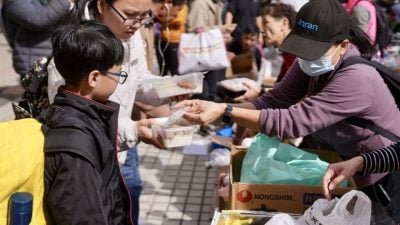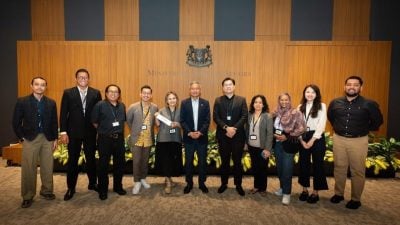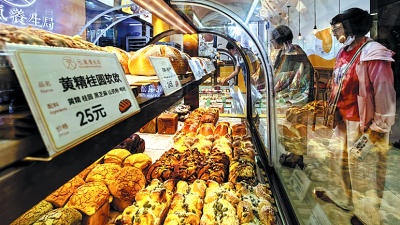
SINGAPORE: Brothers Marcus and Max Tay, who are in their 20s, are a rare sight in Singapore’s largest wet market, where most hawkers and customers are older than them.
In November 2024, they set up The BeefFellas in Chinatown Complex, selling air-flown chilled Japanese wagyu beef, which is trimmed, sliced and vacuum-sealed on the spot.
But young hawkers like them are far from the norm.
The current median age of market stallholders is 63, said the National Environment Agency (NEA), which manages 83 markets or appoints operators to do so.
Occupancy rates remain high, at an average of 96 percent over the past five years. But NEA said consumer behavior has shifted over time due to changing demographics and the widespread availability of alternative options, such as supermarkets and online retailers.
“Many patrons of markets are observed to be older, around 60 years old and above,” it said.
“NEA will continue to assess the needs of the local community and the availability of market produce when considering whether new markets are required.”
Mr Marcus Tay, 29, worked in a local Japanese butchery for four years. His fluency in Japanese means that the stall has attracted Japanese customers too.
“We wanted to sell mainly online but realized that the rental here is affordable,” he told The Straits Times, adding that they pay about $900 (RM2,970) for three stalls monthly, including utilities.
Besides the quality and packaging, personal service is their secret sauce, he said.
“We remember customers’ names and their preferences, and will drop them a message when their preferred items are here.”
Besides their physical market store, they are active online and offer delivery.
While most customers at their physical stall are middle-aged or older, their online customers are younger, they said. They also supply to butcheries and bars.
Mr Max Tay, 24, said that although there are few young hawkers like them, their youth is an advantage.
“People notice us,” he said.
“We have old customers who support us because we are young.”
One of these is Ms Peggy Tan, 72, a retired bank executive who lives in Kovan.
“We must support young people in this trade,” she said. “It’s so rare.”
Another is Mr David Lum, 74, a retired financial consultant living in the Orchard Road area. “I hope to see more young people working in wet markets,” he said. “If not, our wet markets will die one day.”
Wet markets: Are their days numbered?
The latest market built by NEA was Fernvale Hawker Center and Market, which officially opened in 2022. It is also the smallest market by NEA, with about 20 stalls.
Since 2011, the Government has built and opened 14 new hawker centers in newer housing estates, such as Punggol, Bukit Canberra, Jurong West and Woodleigh.
Two of these have wet markets—the one in Fernvale, and another in Bukit Panjang.
Separately, HDB manages 17 wet markets, 13 of which are rented out to private operators. The remaining four have been sold on 30-year leases.
These 17 markets were mostly built by the Housing Board in the 1990s, originally as part of a larger group of over 20 wet markets to be run by private operators.
Over time, some have been converted to supermarkets to meet residents’ evolving needs, said HDB.

Quality, service and online presence
Like the Tay brothers, 27-year-old Delonix Tan, a third-generation fishball maker of SanDai Fishball in Kim Keat Palm Market, believes having an online presence is key to survival and success.
To extend his customer base beyond Toa Payoh, he launched a website and grew the business’ social media presence to over 20,000 followers on Instagram, over 10,000 on Facebook, and over 8,000 on TikTok.
He said his products also stand out, as he uses yellowtail fish to handcraft his fishballs and yong tau foo from scratch. This differs from many others selling factory-made, surimi-based fishballs.
Al-Masyhur, a halal meat and seafood stall located at Block 724 Ang Mo Kio Central wet market, has also adapted to changing customer habits by embracing the digital space.
It hosts live-stream sales three times a week.
Online sales have grown to about 50 percent more than in-store purchases, said its social media manager Firuz Ali Khan.
“While our physical stall still attracts older, long-time customers, we’ve found new momentum online,” Mr Firuz said.
“But ultimately, it’s the quality of our products and our service that keep customers coming back.
“Walk-in traffic has declined, but instead of seeing that as a setback, we’ve focused on new ways to reach our audience and define our niche in the market,” he added.
Freelance writer Fatmah Khan, 22, agreed that having an online presence is a must for wet market vendors to attract younger customers like her.
She gave the example of how a wet market stall in her Yishun neighborhood, Jeya Spices, had a Hari Raya promotion for ketupat on TikTok.
She placed an order on its website, which was linked to its TikTok account.
“How simple is that? It was a lifesaver, since we just moved into the area and had no idea where to get ketupat to complete our meal,” she said.
Jeya Spices’ Mr J. Jeyaseelan, 35, said his business has grown by about 20 percent since he started going online and on social media from 2020, with the latest being TikTok in 2024.
“We are getting a sea of younger customers eager to cook and learn with our spices,” he said.
He has also ventured into supermarkets, with a spice station at FairPrice Xtra Parkway Parade.
Other regular customers of wet markets are drawn to their fresh offerings and personalized service.
Bai He Herbs at the Chinatown wet market, which is known for its medicinal herbs, spices and herbal tea, has been around for over 40 years.
Its fourth-generation owner, 53-year-old He Xiao Ying, banks on her unique items and personalized service to generate business.
She advises customers on the types of herbs that will help with ailments like flu, cough and nose bleed, and how to prepare them.
“There are fewer young customers, as they’d rather go see a doctor or buy medication from the pharmacies,” she said.
“But I have my regular clientele.”
Similarly, Mr Horace Khoo of Chinatown Yong Tau Foo is confident of his business’ longevity because of his quality food and prompt service.
The 47-year-old helms a yong tau foo stall that his mother started in 1978. The uncooked items are handmade at the Chinatown wet market and snapped up quickly.
“I always maintain good quality of my items and I try them myself to ensure this,” he said.
“I service my customers sincerely—service is king.”
Designer Lawrence Tan, 58, patronizes the stall once every two weeks, as he works nearby.
“The items are very fresh and made on the spot,” he said. “I also go to the wet market near my house in Hougang for fresh chicken and vegetables.”
More changes needed
But more changes may be needed for the next generation of wet market vendors to thrive, say market observers.
For one thing, they may need to extend operating hours.
Unlike supermarkets, which operate late into the night or even round the clock, wet markets are usually open from early morning to around noon.
“Supermarkets cater to younger people whose schedules are busy with work and children, many of whom are unable to shop for food on weekday mornings,” said Associate Professor Lyle Fearnley, associate head of humanities, arts and social sciences at the Singapore University of Technology and Design.
Digitalization may help overcome the challenge posed by short opening hours, said Associate Professor Lau Kong Cheen, the Singapore University of Social Sciences’ marketing program head.
He suggested that government agencies provide a framework to help wet market vendors upgrade their business models using technology, branding and digital engagement.
At present, eligible stallholders can apply for the Hawkers’ Productivity Grant to purchase equipment to improve productivity, such as electric fish scalers and bone saws.
They can also benefit from a subsidy under the Hawkers Go Digital program when adopting e-payments.
In addition, one-off rental support of $600 per stall is being given to cooked food and market stallholders across hawker centers and markets managed by government and government-appointed operators, including those managed by NEA or NEA-appointed operators.
The funds have been disbursed progressively from April 2025. The move is also in celebration of Singapore’s diamond jubilee and the fifth anniversary of the inscription of Singapore’s hawker culture on the Unesco Representative List of Intangible Cultural Heritage of Humanity.
HDB said that it has kept rents unchanged for the past five years to keep costs low for market operators.
Observers also cited the importance of comfort and cleanliness.
Prof Lau said there is a need to upgrade the infrastructure of wet markets to make them more conducive for a younger generation of customers.
Professor Lawrence Loh of NUS Business School said air-conditioning the wet markets will help, but this will increase the rentals and prices. He is unsure if public funds should be allocated to help wet markets flourish.
“It will be difficult to prop up a fading sector and upkeep the vanishing trades of wet market stallholders,” he said.
“Wet markets may just dwindle into the twilight by themselves.”
But Professor Lily Kong, who is president of Singapore Management University, made a case for their continued existence.
She has done extensive research into Singapore’s hawker culture and authored two editions of a book which celebrates Singapore’s hawker centers.
Wet markets are not just places to buy produce, but also vibrant cultural ecosystems that nurture community bonds and traditions, she said.
This is especially so for older generations that see them as spaces of belonging and routine.
“Looking ahead, with Singapore’s ageing population, we must reimagine retail spaces as social spaces that serve our seniors’ needs,” she said.
“Traditional wet markets excel at this. They are natural gathering places where seniors maintain social connections while going about their daily marketing.”

ADVERTISEMENT
ADVERTISEMENT








































